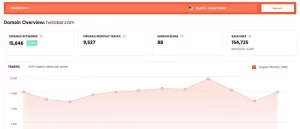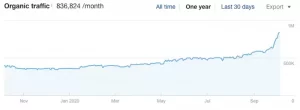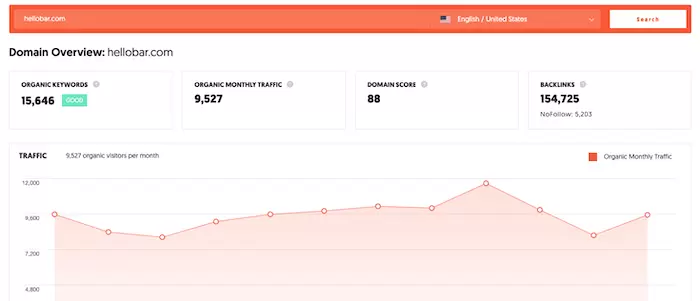7 Ways to Discover the Traffic Data and Incoming Traffic to a site
Because site traffic represents the number of people who have visited your site, it can be considered the foundation of your website—no site traffic. No one reads, clicks, registers, logs in, or buys on the site.
Surely you are checking your site traffic every day. But are you also aware of what exactly you should be looking for? Or how should you check your competitors’ website traffic?
Let’s talk a bit about why and how to monitor and promote your site traffic and see how to get website traffic that is a competitor to you in terms of search engine results and understand where they come from.
Why should you monitor your website traffic?
When you have not measured something, you can not upgrade it.
It does not matter if you want to sell more, get more emails on your site, or increase your advertising revenue; whatever your goal is, the first thing you need to know is whether you are currently in Are you on the right track or not?
This means diving and immersing yourself in website statistics to determine where your site traffic is coming from and how it relates to your site (you also need to know all about your competitors).
So how do you do all this cool stuff?
How to analyze your website traffic?
There is only one standard tool you can use to analyze site traffic: Google Analytics.
Google Analytics, which connects directly to the website in question, shows exactly how many people have visited the site, what source they came to the site, and how they interact with the site content.
Which of these data should be paid more attention to?
Site traffic statistics and things to keep in mind are:
- Unique visitors: People who visit your site at least once in a selected period
- Pageviews: The number of pages that have been visited on your site in a selected period
- Organic search traffic: The number of people who enter and visit the site through a search on Google or any other search engine
- Other traffic channels: How many visitors your site uses through communication channels such as Facebook and YouTube and referral traffic (i.e., a visit that results from a click of visitors to a link to your site
- displayed on another website). Alluring
Although Google Analytics collects many other statistics, these are just a few of the things to keep in mind when analyzing your site traffic.
But if you decide to look at your competitors’ website traffic, the situation is not so simple.
Analyze other people’s website traffic
When you check traffic to sites that do not belong to you, you usually look for more information than just the number of visitors. Here are some good reasons to analyze your competitors’ sites:
- Identify the post or products that generate the most organic traffic to your site
- Identify the keywords that generate the most traffic for the site
- Identify the channels that drive the most traffic to the site
Unfortunately, you can’t sign in to your Google Analytics account and use this data. So where do you think you should find them?
The best tool for checking website traffic
There is a wide range of free and paid tools that you can use to check website traffic. The following tools are very popular in this field and are worth introducing and reviewing.
Ubersuggest
The Ubersuggest tool is well priced compared to other tools and has a unique combination of SEO courses, training, research tools, traffic estimation, and keyword information.

Ahrefs
Ahrefs is one of the most popular and complete SEO audit tools in this field. Organic search overview reports give the user a good view of the type of organic traffic the site receives and the keywords that drive the most traffic. You can use this data to find keywords that drive traffic to your competitors.
Ahrefs only gives you an estimate of the site’s organic traffic. But it does not tell you anything about traffic from sources like social media.

A test conducted by Ahrefs shows that their tool can get organic and unique visitors to 74.14% of all websites they search. The tool also has a free seven-day trial period, after which you must choose one of their paid plans.
SEMrush
SEMrush, like Ahrefs, is a complete SEO tool with a wide range of useful operational features. One of these tools is Traffic Analytics, which provides data such as unique visitor estimates, traffic sources, top pages, and more.
SEMrush also shows you which keywords to use to put your competitors at the top of the site rankings. Accordingly, based on the number of keyword searches, you can estimate how much traffic each keyword has brought to your competitors.

SEMrush has a free version that includes all of a site’s organic traffic and its top five keywords. If you need more details, you need to get a special and paid version.
SimilarWeb
SimilarWeb provides an overview of the site’s total traffic, top traffic sources, and the countries from which the most traffic comes. However, it is important to know that SimilarWeb has limited data and usually does not show results for small or newly launched websites.
A test conducted by ScreamingFrog on SimilarWeb found that it is the most accurate and accurate tool for monitoring website traffic compared to Ahrefs and SEMrush, and has only a one percent error in estimating organic traffic. However, Ahrefs offers much better results for high-traffic sites.
SimilarWeb has a free version that gives you an estimate of the monthly visits to the site and the five keywords used to rank high in searches. Also, if you want to find information about unique visitors and other keywords that have helped the site excel in the rankings, you will have to pay a fee to get a visa.
Serpstat
The free version of Serpstat provides an estimate of the site’s total traffic, top ten keywords, and top ten most visited pages. This tool also helps to evaluate site traffic during different times. For more detailed information, you need its monetary plans.

SE Ranking
SE Ranking allows you to check organic website traffic and identify keywords that have earned them high search rankings. This site also has several different non-free designs. The cost depends on the type and number of benefits and features you need, the number of times the site ranking is updated to your liking, and the duration of using the designs. If you want to try the site for a while, you can use the free 14-day trial.
Alexa
Alexa has both free and paid versions. The free version of Alexa is somewhat limited and shows the ranking of each website based only on its location in Alexa and not on its actual traffic. To estimate the right traffic, you have to sign up for its special plan (or use its 30-day trial period).
It is also good to know that Alexa only has data about multiple direct sources and sites visited by millions of users in its data panels. It is possible that you will not find your competitors there.
While using one of the above tools is the easiest way to track the traffic of competing websites, there are other ways to do so. Those methods require a little more work but can lead you to more accurate results.
Conclusion
There are several ways to measure traffic to competitors’ sites. You can also use different tools, do some data mining on the sites, or ask them directly. While using the tools will usually get you the results as efficiently as possible, you should also be aware that any traffic reported to you is purely an estimate.
Installing and using Google Analytics is the easiest way to check your site traffic and traffic statistics. It tells you exactly how many people have visited your site from each source, and it also makes it easier for you to analyze what you need to work on later.

